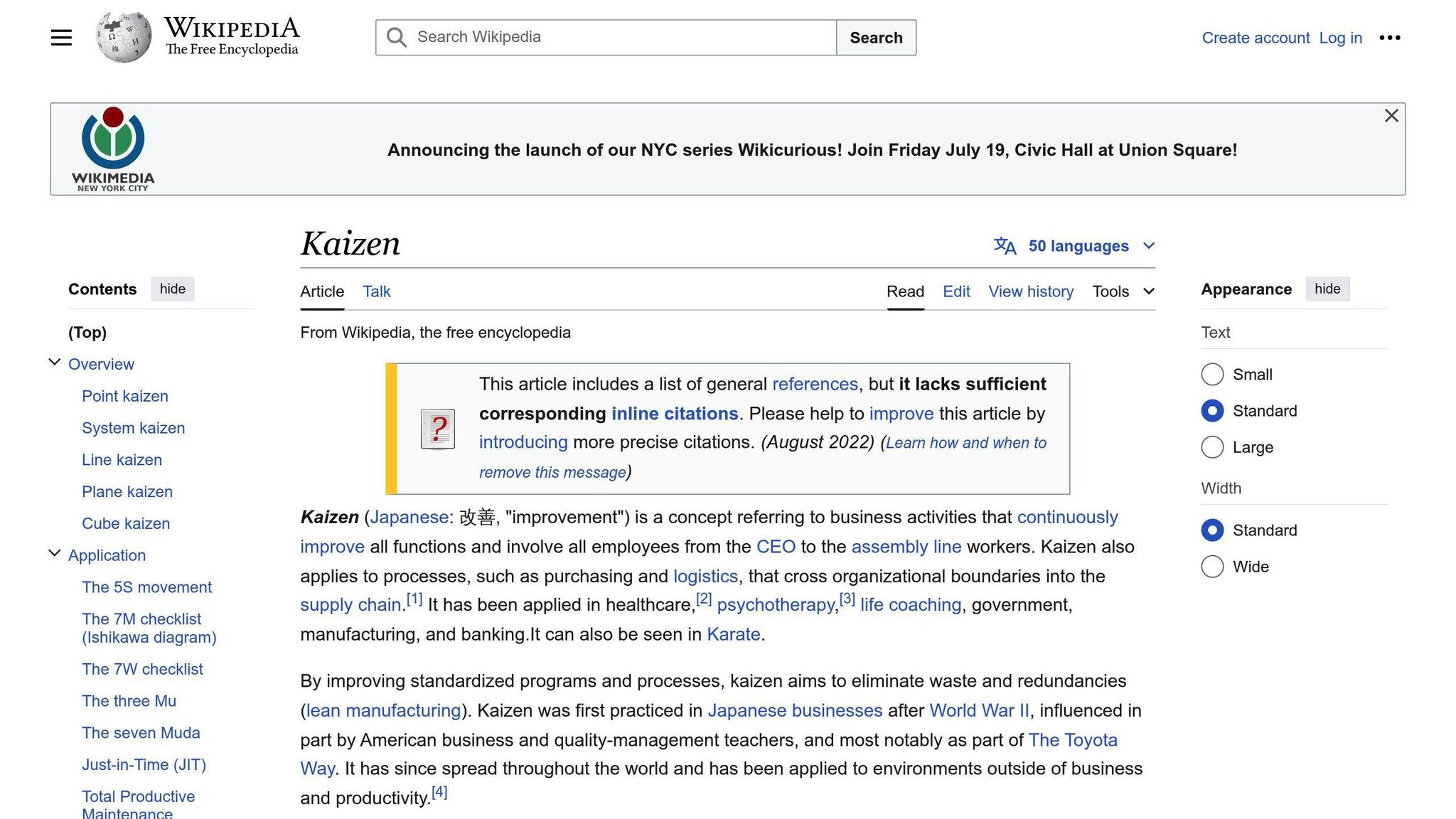9 Lean Practices to Boost Inventory Turnover
Want to sell stock faster and free up cash? Here are 9 lean practices to speed up inventory turnover:
- Just-in-Time (JIT) inventory
- Better demand forecasting
- Right-sizing inventory
- Always improving (Kaizen)
- Mapping value streams
- 5S organization method
- Kanban system
- Working well with suppliers
- Real-time inventory tracking
These methods cut waste, streamline processes, and keep products moving quickly.
Why it matters:
- Less money tied up in stock
- Lower storage costs
- Reduced risk of outdated products
| Practice | What It Does | Benefit |
|---|---|---|
| JIT | Match production to demand | Cuts storage costs |
| Demand forecasting | Predict future sales | Avoid overbuying |
| 5S | Organize workspace | Faster retrieval |
| Kanban | Visual cues for restocking | Prevent stockouts |
| Real-time tracking | Monitor stock levels | Better decisions |
Implementing these practices isn't always easy. Common issues include employee resistance, poor data, and supplier hiccups. But with the right approach, you can overcome these hurdles and see big gains in inventory turnover.
Remember: Track key metrics like Inventory Turnover Ratio (ITR) and Days Sales of Inventory (DSI) to measure success and adjust as needed.
Related video from YouTube
Problems with slow inventory turnover
Slow inventory turnover is a major headache for businesses. Here's why it's bad news and what causes it.
Effects of slow turnover
Slow turnover locks up cash and eats into profits:
1. Cash flow problems
When products collect dust, so does your money. You can't use that cash for other business needs.
Think about it: Buying $5,000 of product at once ties up $5,000. But buying in $1,000 chunks? That lets you reinvest as you sell.
2. High carrying costs
The longer inventory sits, the more you pay to store it.
3. Risk of obsolescence
Products can go out of style or expire. That's "dead stock" - stuff that hasn't sold in over a year.
4. Missed opportunities
Cash trapped in inventory can't fuel growth or new products.
Why turnover slows down
Several culprits can gum up your inventory turnover:
1. Poor demand forecasting
Overbuying leads to excess stock. This often happens when businesses ignore sales cycles or seasonal shifts.
2. Ignoring slow movers
Many stores only track turnover for best-sellers. Slower items pile up and drag down overall turnover.
3. Economic shifts
Sudden changes in the economy or competition can tank demand.
4. Supply chain fears
Some businesses overstock due to recent supply issues. It reduces stockouts but slows turnover.
5. Outdated processes
Old-school inventory management makes it tough to boost efficiency and cut order times.
| Industry | Inventory Turnover Issue | Impact |
|---|---|---|
| Retail | 16% year-over-year inventory increase in home improvement | $544 million extra carrying costs across S&P 1500 retailers |
| Auto Parts | Average 96-day inventory turnover (3.8 turns per year) | Ties up working capital, increases obsolescence risk |
Fixing slow turnover means taking a hard look at your inventory practices. You might need to upgrade to cloud-based software, tweak purchasing schedules, or rethink how you predict demand.
9 lean practices to speed up turnover
Let's look at nine lean methods to boost your inventory turnover:
1. Just-in-Time (JIT) inventory
JIT matches production with demand, cutting waste. You order materials as needed, not in advance.
Toyota mastered JIT over 20 years. They only order car parts after getting new orders. This:
- Cuts storage costs
- Reduces waste
- Improves cash flow
But JIT needs reliable suppliers and steady production.
2. Better demand forecasting
Use data analytics to predict future sales. This helps avoid overbuying.
3. Right-sizing inventory
Keep stock levels matching demand:
- Cut safety stock
- Stock up on fast movers
- Phase out slow sellers
4. Always improving (Kaizen)

Kaizen means small, ongoing improvements. For inventory, try:
- Tweaking order amounts
- Improving storage methods
- Updating tracking systems
5. Mapping value streams
Make a visual map of your inventory flow. It shows bottlenecks and waste.
6. 5S organization method
5S keeps your warehouse tidy and efficient:
| Step | Action | Benefit |
|---|---|---|
| Sort | Remove unneeded items | Less clutter |
| Set in Order | Organize what's left | Faster retrieval |
| Shine | Clean and inspect | Maintains equipment |
| Standardize | Create consistent processes | Everyone follows best practices |
| Sustain | Make 5S a habit | Keeps improvements going |
Brandon Verzal from Stanley Black & Decker says:
"5S is a methodology that results in a clean, uncluttered and safer workplace."
7. Kanban system

Kanban uses visual cues for restocking:
- Green: Stock is good
- Yellow: Time to reorder
- Red: Urgent restock needed
This prevents stockouts without overstocking.
8. Working well with suppliers
Build strong supplier relationships for:
- Faster deliveries
- Better terms
- Flexible ordering
9. Real-time inventory tracking
Use tech to track stock levels as they change. Get up-to-the-minute data for better decisions.
sbb-itb-b5aecec
How to measure improvement
To see if lean practices boost inventory turnover, you need to track key numbers and act on what you find.
Key numbers to watch
Focus on these metrics:
- Inventory Turnover Ratio (ITR): How often you sell and replace inventory yearly. ITR = Cost of Goods Sold / Average Inventory
- Days Sales of Inventory (DSI): How long it takes to sell your inventory. DSI = (Average Inventory / Cost of Goods Sold) x 365
- Sell-Through Rate (STR): Percentage of inventory sold vs. received. STR = (Number of Units Sold / Number of Units Received) x 100
| Metric | Good | Bad |
|---|---|---|
| ITR | Higher | Lower |
| DSI | Lower | Higher |
| STR | Higher | Lower |
Track and tweak
1. Use software: Monitor metrics in real-time with inventory management tools.
2. Set goals: Create benchmarks based on industry standards and your past performance.
3. Check often: Review metrics weekly or monthly to spot trends.
4. Take action: If numbers aren't improving, figure out which lean practices need work.
5. Adjust: Change one practice at a time to see its impact.
For example, if you start using Just-in-Time (JIT) inventory, your DSI should drop. If it doesn't, you might need better supplier relationships or demand forecasting.
Remember: These metrics are your compass. They'll tell you if you're on the right track or if you need to change course.
Possible problems and solutions
Implementing lean practices to boost inventory turnover isn't always smooth sailing. Let's dive into common issues and how to fix them.
Common roadblocks
- Change resistance: Employees might push back, fearing job loss or routine changes.
- Leadership gap: Without top-level support, lean efforts often fizzle out.
- Data mess: Inaccurate inventory data can skew turnover rates and lead to poor decisions.
- Supplier hiccups: Just-in-Time (JIT) inventory needs rock-solid supplier relationships.
- Seasonal rollercoaster: Some products have peak seasons, making lean inventory tricky.
Overcoming obstacles
1. Win over your team
- Show how lean practices benefit everyone
- Provide skill-building training
- Ask for employee input on changes
2. Get the bosses on board
- Highlight cost savings and profit boosts
- Use hard numbers to prove lean's worth
3. Clean up your data act
- Invest in solid inventory tracking software
- Train staff to use new systems correctly
4. Strengthen supplier bonds
- Collaborate closely for on-time deliveries
- Share sales data for better planning
5. Ride the seasonal waves
- Use historical data to forecast needs
- Adjust stock levels seasonally
| Problem | Fix |
|---|---|
| Employee resistance | Train, explain, involve |
| Leadership skepticism | Show ROI with real data |
| Poor data | Upgrade tracking software |
| Weak supplier links | Collaborate, share info |
| Seasonal fluctuations | Use past data to plan |
"No top support? That's a Lean dream killer." - Keyan Zandy, Skiles Group CEO
Keep your lean machine running smooth. Track key metrics like Inventory Turnover Ratio (ITR) and Days Sales of Inventory (DSI). If something's off, tweak one thing at a time to find what works.
Wrap-up
Let's recap the 9 lean practices that can boost your inventory turnover:
- Just-in-Time (JIT) inventory
- Better demand forecasting
- Right-sizing inventory
- Always improving (Kaizen)
- Mapping value streams
- 5S organization method
- Kanban system
- Working well with suppliers
- Real-time inventory tracking
These practices work together to cut waste, speed up processes, and keep your inventory moving fast.
Long-term gains
Faster inventory turnover isn't just a quick win. It brings lasting benefits:
- Lower costs: Less money tied up in stock means more cash for other needs.
- Higher profits: Selling inventory quickly can boost your bottom line.
- Better cash flow: Fast-moving stock keeps money flowing through your business.
- Happy customers: Having the right products at the right time keeps buyers coming back.
| Benefit | How it helps |
|---|---|
| Lower costs | Less storage space needed |
| Higher profits | Reduced holding costs |
| Better cash flow | Quicker return on investment |
| Happy customers | Products always in stock |
Lean practices aren't a one-time fix. They need ongoing work and tweaking. But the payoff is worth it. Companies that use lean methods often see big jumps in their inventory turnover.
"Nearly 30 percent of companies are adopting lean principles in their inventory management."
This shows that more businesses are catching on to the power of lean. By joining them, you're setting up your company for long-term success in a fast-paced market.